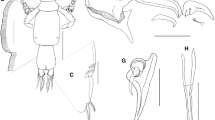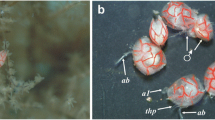Abstract
An eulimid gastropod, Megadenus atrae n. sp., endoparasitic in the cloacal chamber of the black sea cucumber Holothuria atra Jaeger is described from Okinawa, Japan, as the fifth species of the genus. Conspecific specimens have also been found from southeast India, northeast Australia and New Caledonia. The generic assignment is justified by the presence of (i) a thick, long proboscis that bears a large fold (pseudopallium) near the base and a collar-like structure at the middle, (ii) a thin, globose shell that is covered by the pseudopallium, and (iii) sexual dimorphism with the female generally larger than the male. The new species is distinguishable from the four previously described congeners by its cauldron-shaped pseudopallium, moderately-developed collar of the proboscis and rounded basal lip of the shell. The comparisons of the size and sex of solitary and paired individuals support a previous hypothesis that the species of Megadenus Rosén, 1910 are protandrous with environmental sex determination. The present species occurs mostly as monogamous pairs despite its very low population density, implying that the presence of a conspecific individual acts as a cue for larval settlement. Both mechanisms would increase individual reproductive success in such permanent parasites with low prevalence and abundance as the species of Megadenus.


Similar content being viewed by others
References
Arndt, A., Marquez, C., Lambert, P., & Smith, M. J. (1996). Molecular phylogeny of eastern Pacific sea cucumbers (Echinodermata: Holothuroidea) based on mitochondrial DNA sequence. Molecular Phylogenetics and Evolution, 6, 435–437.
Bouchet, P., Lozouet, P., Maestrati, P., & Heros, V. (2002). Assessing the magnitude of species richness in tropical marine environments: exceptionally high numbers of molluscs at a New Caledonia site. Biological Journal of the Linnean Society, 75, 421–436.
Bouchet, P., & Lützen, J. (1980). Deux gastéropodes parasites d’unc holothurie élasipode. Bulletin du Museum d’Historie Naturelle, Paris, 4 e sér., 2, 59–75.
Chao, S.-M., Chen, C.-P., & Alexander, P. S. (1993). Fission and its effect on population structure of Holothuria atra (Echinodermata: Holothuroidea) in Taiwan. Marine Biology, 116, 109–115.
Cochran, W. G. (1954). Some methods for strengthening the common χ2 tests. Biometrics, 10, 417–451.
Collin, R. (1995). Sex, size, and position: a test of models predicting size at sex change in the protandrous gastropod Crepidula fornicata. American Naturalist, 146, 815–831.
Crossland, M. R., Collins, J. D., & Alford, R. A. (1993). Host selection and distribution of Hypermastus placentae (Eulimidae), an ectoparasitic gastropod on the sand dollar Arachnoides placenta (Echinoidea). Australian Journal of Marine and Freshwater Research, 44, 835–844.
Fretter, V., & Graham, A. (1982). The prosobranch molluscs of Britain and Denmark, Part 7. ‘Heterogastropoda’. Journal of Molluscan Studies, Supplement, 11, 363–434.
Goto, R. (2010). First record of the genus Megadenus Rosén, 1910 (Gastropoda: Eulimidae), endoparasites of sea cucumbers, from Japan. Venus, 69, 80–83.
Héros, V., Lozouet, P., Maestrati, P., von Cosel, R., Brabant, D., & Bouchet, P. (2007). Mollusca of New Caledonia. In: Payri, C. E. & Richer de Forges B. (Eds), Compendium of marine species of New Caledonia. Documents Scientifiques et Techniques 117, second edition. Nouméa: IRD, pp. 199–254.
Humphreys, W. F., & Lützen, J. (1972). Studies on parasitic gastropods from echinoderms I. On the structure and biology of the parasitic gastropod Megadenus cantharelloides n. sp., with comparisons on Paramegadenus n. g. Det Kongelige Danske Videnskabernes Selskab Biologiske Skrifter, 19, 1–27.
ICZN. (2012). International Commission on Zoological Nomenclature: Amendment of articles 8, 9, 10, 21 and 78 of the International Code of Zoological Nomenclature to expand and refine methods of publication. Zootaxa, 3450, 1–7.
Jones, S., & James, D. B. (1969). On a stiliferid gastropod parasitic in the cloacal chamber of Holothuria atra Jaeger. Proceedings of the Symposium on Mollusca, Marine Biological Association of India, 3, 799–804.
Lester, R. J. G., & Sewell, K. B. (1989). Checklist of parasites from Heron Island, Great Barrier Reef. Australian Journal of Zoology, 37, 101–128.
Long, D. J., & Waggoner, B. M. (1993). The ectoparasitic barnacle Anelasma (Cirripedia, Thoracica, Lepadomorpha) on the shark Centroscyllium nigrum (Chondrichthyes, Squalidae) from the Pacific sub-Antarctic. Systematic Parasitology, 26, 133–136.
Lozouet, P. (2014). Temporal and latitudinal trends in the biodiversity of European Atlantic Cenozoic gastropod (Mollusca) faunas. A base for the history of biogeographic provinces. Carnets de Géologie, 14, 273–314.
Lützen, J., & Nielsen, K. (1975). Contributions to the anatomy and biology of Echineulima n. g. (Prosobranchia, Eulimidae), parasitic on sea urchins. Videnskabelige Meddelelser fra Dansk Naturhistoriske Forening, 138, 171–199.
Matsuda, H., Hamano, T., & Nagasawa, K. (2010). Spatial distribution patterns of the parasitic gastropod Hypermastus tokunagai (Eulimidae) in populations of its echinoid host Scaphechinus mirabilis (Scutellidae). Venus, 69, 59–70.
Matsuda, H., Hamano, T., & Nagasawa, K. (2013). Growth and reproductive cycle of Hypermastus tokunagai (Caenogastropoda: Eulimidae), an ectoparasite of the sand dollar Scaphechinus mirabilis (Clypeasteroida: Scutellidae) in the Seto Inland Sea, Japan. Journal of the Marine Biological Association of the United Kingdom, 93, 1041–1051.
Monterosato, T. A. di. (1908). Note sur l’Eulima ptilocrinicola. Journal de Conchyliologie, 56, 116–118.
Morishita, M. (1959). Measuring of the dispersion and analysis of the distribution patterns. Memoirs of the Faculty of Science, Kyusyu University. Series E, Biology, 2, 215–235.
Poulin, R. (2007). Evolutionary Ecology of Parasites (2nd ed.). Princeton: Princeton University Press.
Ram Mohan, M. K., & James, D. B. (2005). An incidence of parasitic infestation in Holothuria atra Jaeger. Beche-de-mer Information Bulletin, 22, 38.
R Core Team. (2015). R: A language and environment for statistical computing, version 3.2.2. R Foundation for Statistical Computing, Vienna, Austria. Available at http://www.r-project.org/.
Rees, D. J., Noever, C., Høeg, J. T., Ommundsen, A., & Glenner, H. (2014). On the origin of a novel parasitic-feeding mode within suspension feeding barnacles. Current Biology, 24, 1429–1434.
Rosén, N. (1910). Zur Kenntnis der parasitischen Schnecken. Lunds Universitets Ärsskrift, 6(4), 1–67.
Schepman, M. M., & Nierstrasz, H. F. (1914). Parasitische und kommensalistische Mollusken aus Holothurien. Reise in Ostafrika in den Jahren 1903–1905 mit mittein der Hermann und Elise geb. Heckmann Wentzel-Stiftung ausgeführt von Professor Dr. Alfred Voeltzkow, Wissenschaftliche Ergebnisse, 4, 383–416.
Sella, G., & Ramella, L. (1999). Sexual conflict and mating systems in the dorvilleid genus Ophryotrocha and the dinophilid genus Dinophilus. Hydrobiologia, 402, 203–213.
Takano, T., & Kano, Y. (2014). Molecular phylogenetic investigations of the relationships of the echinoderm-parasite family Eulimidae within Hypsogastropoda (Mollusca). Molecular Phylogenetics and Evolution, 79, 258–269.
Tamura, K., Peterson, D., Peterson, N., Stecher, G., Nei, M., & Kumar, S. (2011). MEGA5: molecular evolutionary genetics analysis using maximum likelihood, evolutionary distance, and maximum parsimony methods. Molecular Biology and Evolution, 28, 2731–2739.
Tsai, M.-L., Li, J.-J., & Dai, C.-F. (1999). Why selection favors protandrous sex change for the parasitic isopod, Ichthyoxenus fushanensis (Isopoda: Cymothoidae). Evolutionary Ecology, 13, 327–338.
Uthicke, S., Byrne, M., & Conand, C. (2010). Genetic barcoding of commercial Bêche-de-mer species (Echinodermata: Holothuroidea). Molecular Ecology Resources, 10, 634–646.
Warén, A. (1980a). Revision of the genera Thyca, Stilifer, Scalenostoma, Mucronalia and Echineulima (Mollusca, Prosobranchia, Eulimidae). Zoologica Scripta, 9, 187–210.
Warén, A. (1980b). Descriptions of new taxa of Eulimidae (Mollusca, Prosobranchia), with notes on some previously described genera. Zoologica Scripta, 9, 283–306.
Warén, A. (1981). Eulimid gastropods parasitic on echinoderms in the New Zealand region. New Zealand Journal of Zoology, 8, 313–324.
Warén, A. (1984). A generic revision of the family Eulimidae (Gastropoda, Prosobranchia). Journal of Molluscan Studies, Supplement, 13, 1–96.
Acknowledgements
We thank P. Bouchet, H. Fukumori, H. Hidaka and G. Kobayashi for their help in the fieldwork. Invaluable comments were provided by P. Bouchet and K. Seike for the improvement of the manuscript.
Funding
Financial support was provided by KAKENHI grant from the Japan Society for the Promotion of Science (nos 26291077 and 15J10840) and Sasakawa Scientific Research Grant from The Japan Science Society (25-529).
Author information
Authors and Affiliations
Corresponding author
Ethics declarations
Conflict of interest
The authors declare that they have no conflict of interest.
Ethical approval
All applicable institutional, national and international guidelines for the care and use of animals were followed.
Additional information
This article was registered in the Official Register of Zoological Nomenclature (ZooBank) as urn:lsid:zoobank.org:pub:73AECE62-07A8-4C09-99F5-B27B54370D5C. This article was published as an Online First article on the online publication date shown on this page. The article should be cited by using the doi number. This is the Version of Record.
Rights and permissions
About this article
Cite this article
Takano, T., Warén, A. & Kano, Y. Megadenus atrae n. sp., an endoparasitic eulimid gastropod (Mollusca) from the black sea cucumber Holothuria atra Jaeger (Aspidochirotida: Holothuriidae) in the Indo-West Pacific. Syst Parasitol 94, 699–709 (2017). https://doi.org/10.1007/s11230-017-9731-7
Received:
Accepted:
Published:
Issue Date:
DOI: https://doi.org/10.1007/s11230-017-9731-7




